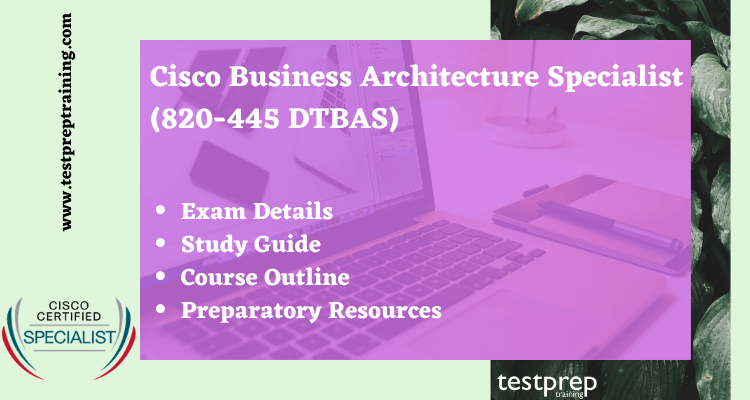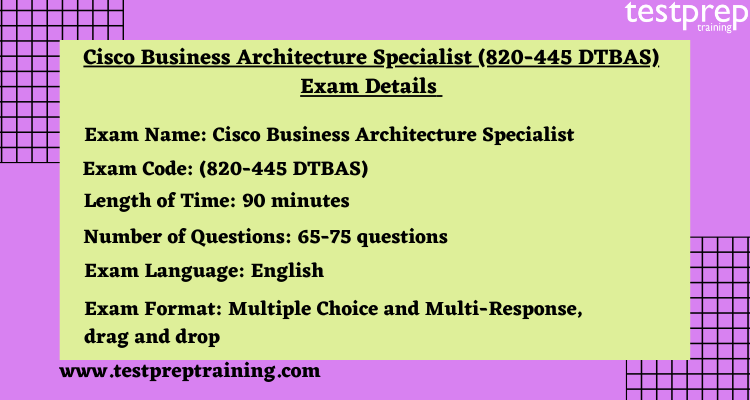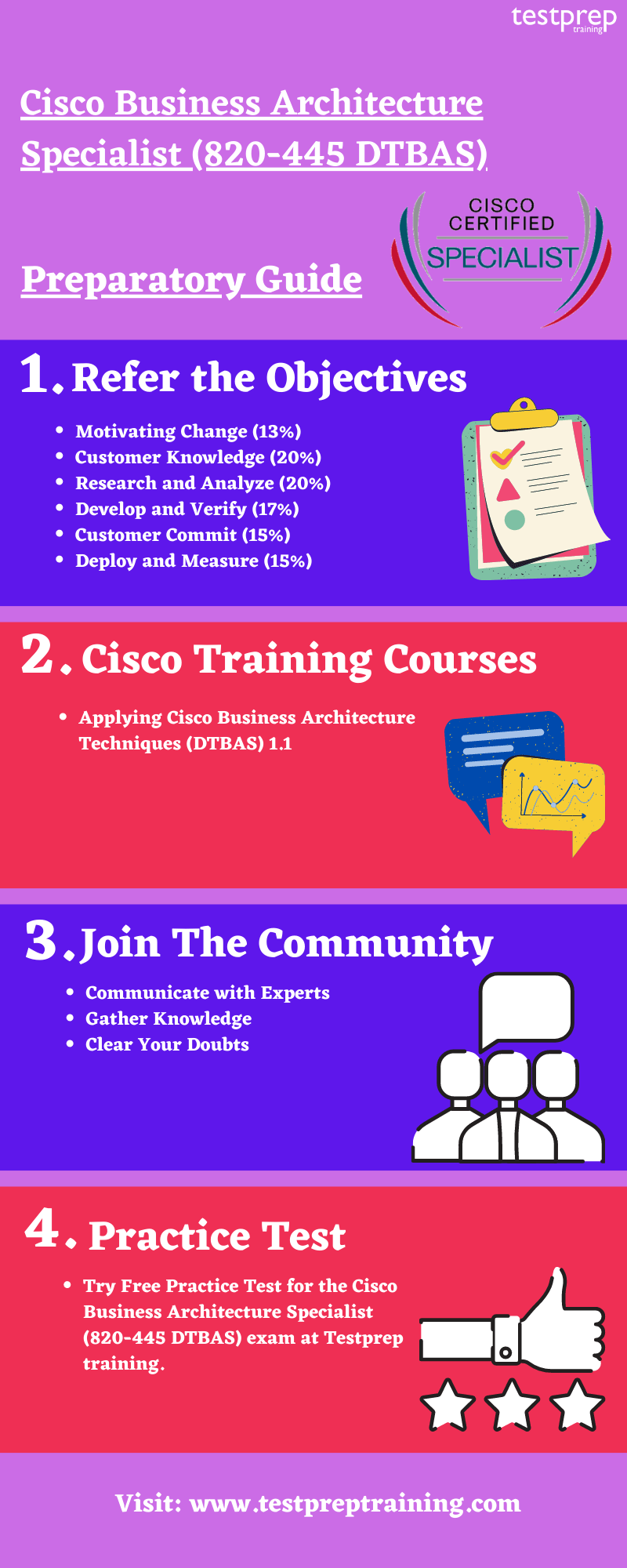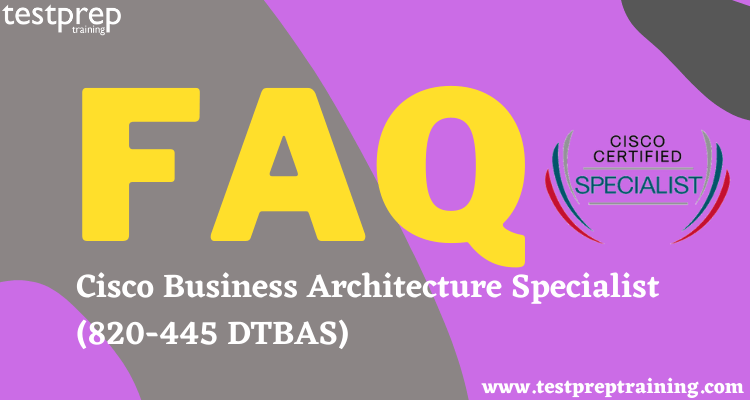Cisco Business Architecture Specialist (820-445 DTBAS)

The Cisco Business Architecture Specialist (820-445 DTBAS) exam is a key to obtain the Cisco Business Architecture Specialist certification. The Cisco Business Architecture Specialist is a certification program that picks up from the Business Architecture Analyst certification to continue your journey to becoming a full-fledged Business Architect.
In addition to reinforcing core knowledge, this program develops explicit skills and tools for modelling the business, empowering stakeholders, and achieving the required goals in order to advance the customer’s digital transformation. Develop important customer skills through practicing creating rapport and trustworthiness, encouraging entrepreneurship, and using consultative techniques. This certification is the next step in the candidate’s path to becoming a Business Architect.
Required Skills and Knowledge
The Cisco Business Architecture Specialist (820-445 DTBAS) exam tests a candidate’s knowledge and skills as it relates to:
- Roles related to a Cisco Business Architecture lead sales process
- Specific responsibilities of a business architect
- Customer journey
- Customer credibility and rapport
Target Audience
Account Managers, System Engineers, and Gold Partners who want to get the Channel Partner Business Architecture certification from Cisco.
Learning Path
Cisco provides a variety of certifications in a variety of industries. Cisco offers a variety of certificates, including entry, associate, specialised, professional, expert, and architect. Many certificates were included in each level.
Exam Details
The Cisco Business Architecture Specialist exam has a code of 820-445 DTBAS and is only accessible in English. The test will consist of 65-75 questions, with 90 minutes allotted to answer them. Candidates may encounter a variety of question styles during the exam, including multiple-choice single answer, multiple-choice multiple answers, and drag-and-drop.

To schedule your exam
- Log into your account at Pearson VUE.
- Select Proctored Exams and enter the exam number, 820-445 DTBAS.
- Follow the prompts to register.
Cisco Business Architecture Specialist (820-445 DTBAS) Course Outline
CISCO has divided the syllabus into various sections. The Cisco Business Architecture Specialist (820-445 DTBAS) exam includes its objectives and sub-topics in it. The detailed course outline is mentioned below:
1.0 Motivating Change
- 1.1 Describe the characteristics of a business-led engagement.
- 1.2 Compare and contrast business innovation and disruption.
- 1.3 Describe the characteristics of business outcomes.
- 1.4 Describe the importance of team readiness for the customer and the architect’s team.
- 1.5 Evaluate the maturity level of the customer and the architect’s team.
- 1.6 Identify engagement opportunities based on the architect’s team and customer maturity level.
2.0 Customer Knowledge
- 2.1 Compare and contrast the refined and unrefined business model canvas.
- 2.2 Describe the value of the business model canvas.
- 2.3 Describe the unique characteristics of each building block in the business model canvas.
- 2.4 Create a business model canvas using the provided data.
- 2.5 Identify internal and external business influencers in the context of a SWOT.
- 2.6 Create a PESTLE using the provided data.
- 2.7 Create a SWOT using the provided data.
- 2.8 Describe these elements of a business motivation model.
- 2.9 Describe the purpose of a business motivation model.
- 2.10 Describe the purpose of a value proposition.
- 2.11 Describe the purpose of a value network.
- 2.12 Describe the different layers of strategies within a business environment
3.0 Research and Analyze
- 3.1 Describe the characteristics of a persona.
- 3.2 Describe the use of a stakeholder analysis grid.
- 3.3 Create a stakeholder analysis grid.
- 3.4 Describe the process for transitioning stakeholders from their current to the desired state.
- 3.5 Describe the five steps for conducting a stakeholder analysis.
- 3.6 Identify the four principles of negotiation.
- 3.7 Describe the purpose of the strategic inquiry.
- 3.8 Compare and contrast these items
- 3.9 Describe SMART.
- 3.10 Describe the benefits of establishing credibility and rapport with the customer.
- 3.11 Compare and contrast closed-ended and open-ended questions.
- 3.12 Describe the four best practices for conducting a business conversation.
- 3.13 Describe the five different types of questions to use in business conversations.
- 3.14 Describe the process for conducting the first exploratory conversations
4.0 Develop and Verify
- 4.1 Describe the process to transition from the current state business model to the target state business model.
- 4.2 Describe the three core components of business capabilities.
- 4.3 Describe the purpose of a workshop.
- 4.4 Describe the activities associated with conducting a workshop.
- 4.5 Describe the inputs used to determine the business target state.
- 4.6 Describe business opportunities.
- 4.7 Identify examples of competitive advantage.
- 4.8 Describe the components of the Porter value chain.
- 4.9 Describe the relationship between the value chain and a business model.
- 4.10 Identify key decision-making factors.
- 4.11 Compare and contrast critical success factors and key performance indicators.
- 4.12 Describe the three levels of business capabilities
5.0 Customer Commit
- 5.1 Create a business priority to outcomes map with provided data.
- 5.2 Describe the structured approach to creating a business roadmap.
- 5.3 Compare and contrast the inputs used to create a business roadmap
- 5.4 Describe the final components of a business roadmap.
- 5.5 Describe the value of the business roadmap.
6.0 Deploy and Measure
- 6.1 Describe the characteristics of a trusted advisor.
- 6.2 Describe the components of a business case.
- 6.3 Populate a cause and effect benefit logic model.
- 6.4 Describe the factors associated with delivering a relevant message to the audience.
- 6.5 Compare and contrast the message delivery for these audience types.
- 6.6 Describe the four components used to create an executive summary.
- 6.7 Describe the impact of organizational readiness on an organization’s ability to execute.
- 6.8 Describe the business change lifecycle.
- 6.9 Compare and contrast proof of concept and proof of value.
- 6.10 Describe relevant metrics to measure progress.
- 6.11 Compare and contrast the four levels of governance.
Cisco Business Architecture Specialist (820-445 DTBAS) FAQ
Exam Policies
The candidate should visit the CISCO official website for understanding the terms and policies of the CISCO. The exam terms and policies include various important information such as age requirements and policies concerning minors, candidate identification, and authentication, rights and responsibilities, Confidentiality and agreements, etc.
Preparation Guide for Cisco Business Architecture Specialist (820-445 DTBAS)

The preparation steps which are essential in order to successfully pass the Cisco Business Architecture Specialist (820-445 DTBAS) exam are:
CISCO Official Website
Visiting the CISCO official website is an important step while preparing for the Cisco Business Architecture Specialist (820-445 DTBAS) exam. The official site offers a lot of reliable information and sources which are very helpful in preparing for the exam. The resources such as study guide, sample papers, whitepapers, documentation, faqs, etc. The candidate can find all such important things on the official page.
Review All the objectives
With complete exam objectives, the candidate’s exam preparation time is better spent because they already know what to study. Significantly, this is the most important step in the preparation guide. So, let’s take a quick look at the Objectives of the Cisco Business Architecture Specialist (820-445 DTBAS).
- Motivating Change (13%)
- Customer Knowledge (20%)
- Research and Analyze (20%)
- Develop and Verify (17%)
- Customer Commit (15%)
- Deploy and Measure (15%)
CISCO Training Program
Training programs are a very necessary step in the preparation of such exams like Cisco Business Architecture Specialist (820-445 DTBAS). CISCO offers its own training programs on their various examinations and certifications. For the 820-445 DTBAS exam, it offers:
Applying Cisco Business Architecture Techniques (DTBAS) 1.1
Upon completing this course, you will be able to describe and use design-oriented knowledge for unified computing topics, including:Identify the business model of the customer.
- Understand their value chain. Be able to determine stakeholders and their motivation.
- Formulate a vision and a roadmap to execution.
- Build various artifacts that drive engagements to successful conclusion.
- Drive long-term value and synergies that are mutually beneficial to vendor and customer.
Books and Guides
The next step in the preparatory guide should be books and study guides. The candidate needs to find those books which are enriched with information. Finding a good book may be a difficult task, but in order to gather the knowledge and skills, the candidate has to find, read and understand.
Join a Study Group
Joining a group study will also be beneficial for the candidate. It will encourage them to do more hard work. Also, studying in the group will help them to stay connected with the other people who are on the same pathway as them. Also, the discussion of such study groups will benefit the students in their exams.
Evaluate yourself with Practice Test
Most importantly, candidates have to try their hands-on practice tests. Practice tests are the one that secures the candidate about their preparation. The practice test will help the candidates to recognize their vulnerable areas so that they can work on them. There are many practice tests available on the internet nowadays, so the candidate can choose which they want.


